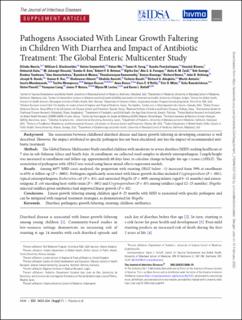| dc.contributor.author | Nasrin, Dilruba | |
| dc.contributor.author | Blackwelder, William C. | |
| dc.contributor.author | Sommerfelt, Halvor | |
| dc.contributor.author | Wu, Yukun | |
| dc.contributor.author | Farag, Tamer H. | |
| dc.contributor.author | Panchalingam, Sandra | |
| dc.contributor.author | Biswas, Kousick | |
| dc.contributor.author | Saha, Debasish | |
| dc.contributor.author | Jahangir Hossain, Hossain | |
| dc.contributor.author | Sow, Samba O. | |
| dc.contributor.author | Reiman, Robert F B | |
| dc.contributor.author | Sur, Dipika | |
| dc.contributor.author | Faruque, Abu Syed Golam | |
| dc.contributor.author | Zaidi, Anita K M | |
| dc.contributor.author | Sanogo, Doh | |
| dc.contributor.author | Tamboura, Boubou | |
| dc.contributor.author | Onwuchekwa, Uma | |
| dc.contributor.author | Manna, Byomkesh | |
| dc.contributor.author | Ramamurthy, Thandavarayan | |
| dc.contributor.author | Kanungo, Suman | |
| dc.contributor.author | Omore, Richard | |
| dc.contributor.author | Ochieng, John B. | |
| dc.contributor.author | Oundo, Joseph O. | |
| dc.contributor.author | Das, Sumon K. | |
| dc.contributor.author | Ahmed, Shahnawaz | |
| dc.contributor.author | Qureshi, Shahida | |
| dc.contributor.author | Quadri, Farheen | |
| dc.contributor.author | Adegbola, Richard A. | |
| dc.contributor.author | Antonio, Martin | |
| dc.contributor.author | Mandomando, Inacio | |
| dc.contributor.author | Nhampossa, Tacilta | |
| dc.contributor.author | Bassat, Quique | |
| dc.contributor.author | Roose, Anna | |
| dc.contributor.author | O'Reilly, Ciara E. | |
| dc.contributor.author | Mintz, Eric D. | |
| dc.contributor.author | Ramakrishnan, Usha | |
| dc.contributor.author | Powell, Helen | |
| dc.contributor.author | Liang, Yuanyuan | |
| dc.contributor.author | Nataro, James Paul | |
| dc.contributor.author | Levine, Myron M. | |
| dc.contributor.author | Kotloff, Karen L. | |
| dc.date.accessioned | 2022-03-07T10:02:58Z | |
| dc.date.available | 2022-03-07T10:02:58Z | |
| dc.date.created | 2022-01-31T17:32:44Z | |
| dc.date.issued | 2021 | |
| dc.identifier.issn | 0022-1899 | |
| dc.identifier.uri | https://hdl.handle.net/11250/2983349 | |
| dc.description.abstract | Background
The association between childhood diarrheal disease and linear growth faltering in developing countries is well described. However, the impact attributed to specific pathogens has not been elucidated, nor has the impact of recommended antibiotic treatment.
Methods
The Global Enteric Multicenter Study enrolled children with moderate to severe diarrhea (MSD) seeking healthcare at 7 sites in sub-Saharan Africa and South Asia. At enrollment, we collected stool samples to identify enteropathogens. Length/height was measured at enrollment and follow-up, approximately 60 days later, to calculate change in height-for-age z scores (ΔHAZ). The association of pathogens with ΔHAZ was tested using linear mixed effects regression models.
Results
Among 8077 MSD cases analyzed, the proportion with stunting (HAZ below −1) increased from 59% at enrollment to 65% at follow-up (P < .0001). Pathogens significantly associated with linear growth decline included Cryptosporidium (P < .001), typical enteropathogenic Escherichia coli (P = .01), and untreated Shigella (P = .009) among infants (aged 0–11 months) and enterotoxigenic E. coli encoding heat-stable toxin (P < .001) and Cryptosporidium (P = .03) among toddlers (aged 12–23 months). Shigella-infected toddlers given antibiotics had improved linear growth (P = .02).
Conclusions
Linear growth faltering among children aged 0–23 months with MSD is associated with specific pathogens and can be mitigated with targeted treatment strategies, as demonstrated for Shigella. | en_US |
| dc.language.iso | eng | en_US |
| dc.publisher | Oxford University Press | en_US |
| dc.rights | Navngivelse 4.0 Internasjonal | * |
| dc.rights.uri | http://creativecommons.org/licenses/by/4.0/deed.no | * |
| dc.title | Pathogens Associated With Linear Growth Faltering in Children With Diarrhea and Impact of Antibiotic Treatment: The Global Enteric Multicenter Study | en_US |
| dc.type | Journal article | en_US |
| dc.type | Peer reviewed | en_US |
| dc.description.version | publishedVersion | en_US |
| dc.rights.holder | Copyright The Author(s) 2021 | en_US |
| cristin.ispublished | true | |
| cristin.fulltext | original | |
| cristin.qualitycode | 2 | |
| dc.identifier.doi | 10.1093/infdis/jiab434 | |
| dc.identifier.cristin | 1995452 | |
| dc.source.journal | Journal of Infectious Diseases | en_US |
| dc.source.pagenumber | S848-S855 | en_US |
| dc.identifier.citation | Journal of Infectious Diseases. 2021, 224 (7), S848-S855. | en_US |
| dc.source.volume | 224 | en_US |
| dc.source.issue | 7 | en_US |

